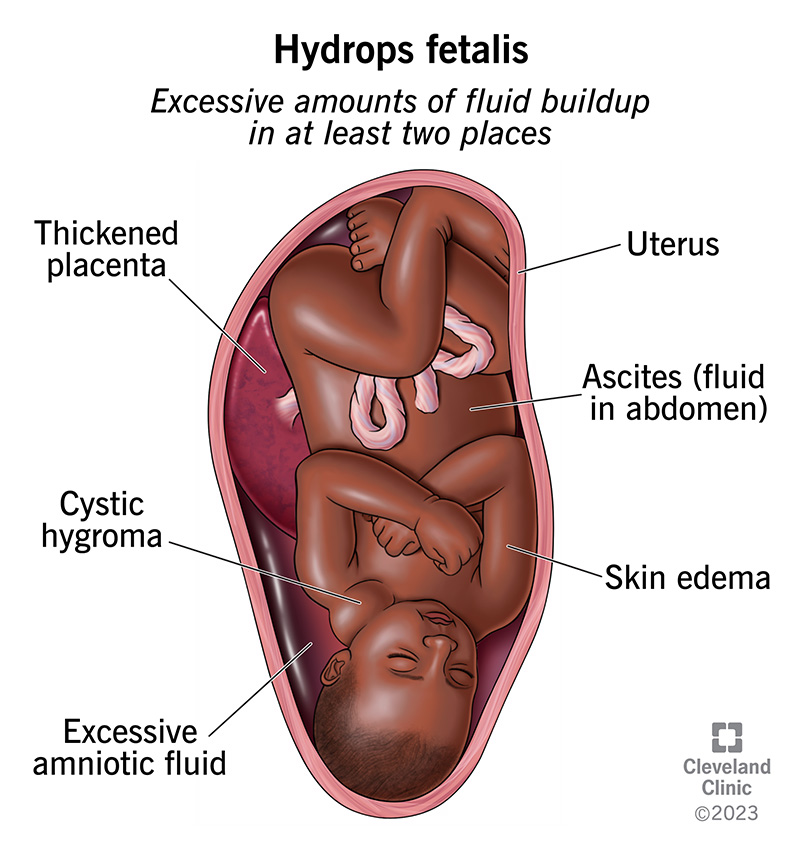Hydrops fetalis, or fetal hydrops, is a serious condition that can affect fetuses and newborns. It happens when fluid accumulates in at least two compartments in the body, leading to severe swelling (edema). Treatment and prognosis depend on the underlying cause of the hydrops. About half of all cases result in death of the newborn.
Advertisement
Cleveland Clinic is a non-profit academic medical center. Advertising on our site helps support our mission. We do not endorse non-Cleveland Clinic products or services. Policy
Hydrops fetalis is a rare, life-threatening condition that occurs when a fetus or newborn has severe swelling (edema). They also have excessive amounts of fluid buildup in at least two body areas. Hydrops fetalis isn’t a disease. It’s a symptom of an underlying health condition affecting the fetus. Another name for hydrops fetalis is fetal hydrops.
Advertisement
Cleveland Clinic is a non-profit academic medical center. Advertising on our site helps support our mission. We do not endorse non-Cleveland Clinic products or services. Policy
Fetal hydrops can lead to:
The treatment and outlook (prognosis) for the condition vary widely depending on the health issue causing the problem. Sometimes, healthcare providers can treat the underlying health issue. Other times, providers can’t treat the underlying condition, and the outlook is poor.
Healthcare providers divide hydrops fetalis into two different types: immune and nonimmune. The cause of the fluid buildup determines the type.

Your healthcare provider may be able to see signs or symptoms of hydrops fetalis on an ultrasound during your pregnancy. These symptoms may include:
Advertisement
In addition, you may have:
After your baby is born, their symptoms may include:
The cause of hydrops fetalis depends on the reason for the fluid buildup (immune hydrops fetalis or nonimmune hydrops fetalis).
Immune hydrops fetalis usually occurs due to a blood type incompatibility between you and the fetus. If you have different Rh factors (you have Rh negative and the fetus is Rh positive), you’ll make antibodies against the fetus’s red blood cells. This leads to total body swelling. You can prevent this type of hydrops fetalis by getting a RhoGAM shot. This is a medicine that stops your immune system from making the antibodies.
Rh incompatibility is the most well-known cause. But other less common causes of immune hydrops include an immune system reaction to other red blood cell antigens, like the Kell, Duffy and Kidd antigens.
Nonimmune hydrops fetalis occurs when the fetus has an underlying disease, a birth defect or a genetic disorder that affects its ability to manage fluid. These include certain:
Hydrops fetalis can lead to spontaneous miscarriage, preterm delivery and early death of your newborn. In babies that survive, other complications may occur, including:
Healthcare providers usually diagnose hydrops fetalis during pregnancy when they can see signs of the condition on a prenatal ultrasound. Your provider may see:
If your provider detects hydrops fetalis, they may refer you to a high-risk obstetrician or maternal-fetal medicine specialist. They’ll work to quickly determine the underlying cause of the condition. Finding out the cause of fetal hydrops is important because some conditions are treatable. You’ll have more tests, including:
Advertisement
Despite these tests, healthcare providers can’t figure out a clear cause of hydrops fetalis in about half of all cases. You’ll work with your providers to determine other possible tests and treatment options. They can tell you more about what to expect during and after pregnancy.
Treatment for hydrops fetalis depends on various factors, including:
Treatment isn’t always possible during pregnancy, but when it is, it may include:
Treatment for a newborn with hydrops fetalis may include:
Advertisement
If your healthcare provider detects hydrops fetalis, they’ll closely monitor your pregnancy. You’ll have frequent ultrasounds and other tests to track your health and the health of the fetus. You may have a team of healthcare specialists who are all working to ensure the best possible outcome for you and your baby. This team may include:
One thing your providers will look out for is a condition called maternal mirror syndrome. This is a type of preeclampsia in which you “mirror” the fetus. You develop severe fluid buildup and swelling and may experience other symptoms. If you develop this condition, you’ll have to deliver your baby early for the health and safety of both of you.
The outlook (prognosis) for fetuses and babies born with hydrops fetalis varies widely based on several factors, including:
The overall survival rate is less than 50%. The development of severe hydrops before the third trimester of pregnancy carries a high mortality. Prognosis is better for treatable causes of hydrops — like fetal arrhythmia — and poorer for causes like severe birth defects.
Advertisement
You can prevent immune hydrops fetalis by getting a RhoGAM shot during and after your pregnancy. This medication prevents your body from producing antibodies against your baby’s red blood cells. You’ll only receive this injection if you’re at risk for Rh incompatibility.
You can’t prevent nonimmune hydrops fetalis.
Pregnancy complications can be scary and stressful, and fetal hydrops is a life-threatening condition. But it’s important to remember that healthcare providers can treat many of the underlying causes of the condition. Work with your healthcare team to find out the cause of hydrops and what your treatment options are. And lean on them for support. No matter the outcome, they’re there to help with the physical and emotional challenges that the condition can bring.
From routine pelvic exams to high-risk pregnancies, Cleveland Clinic’s Ob/Gyns are here for you at any point in life.

Last reviewed on 07/29/2025.
Learn more about the Health Library and our editorial process.